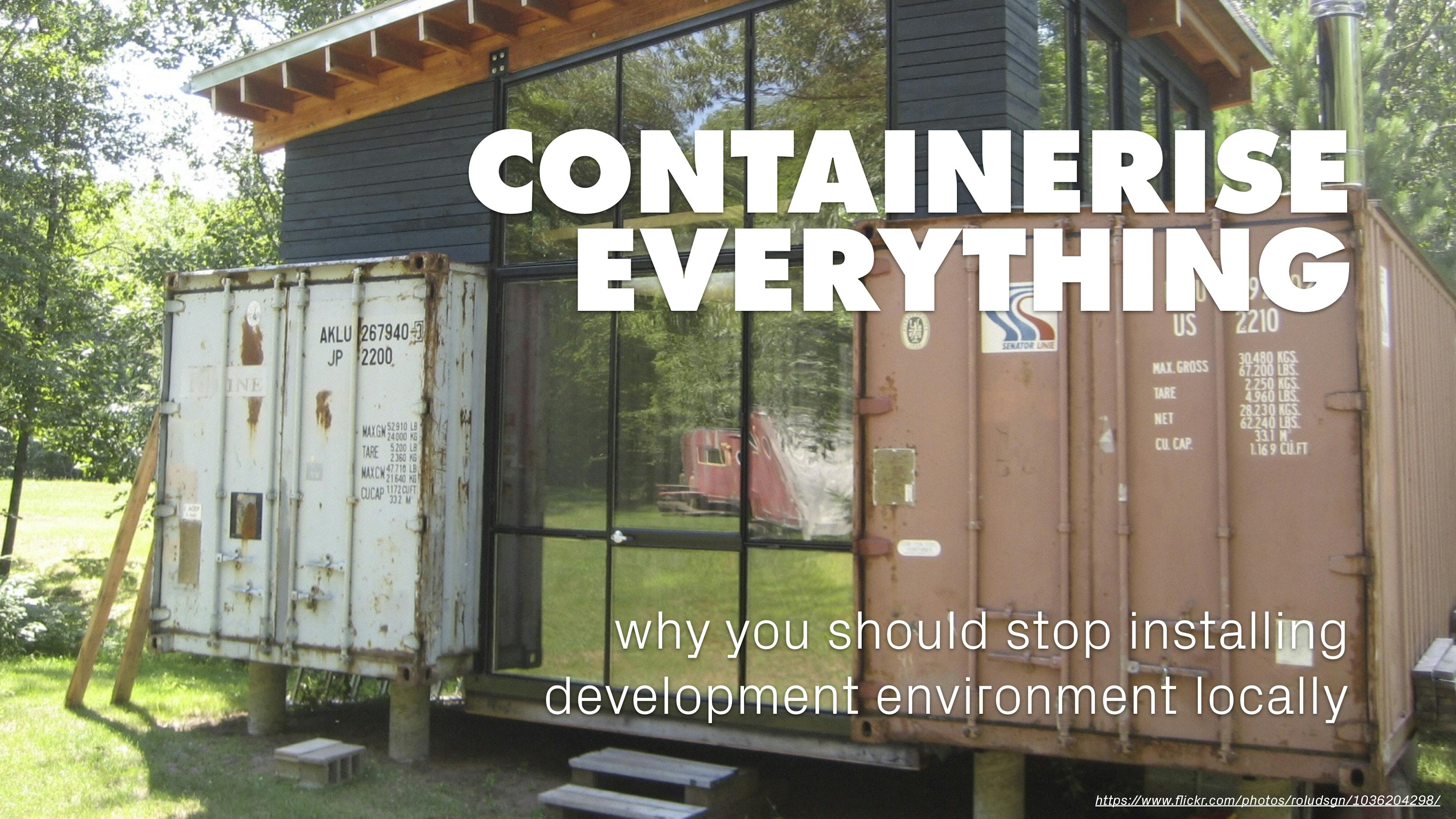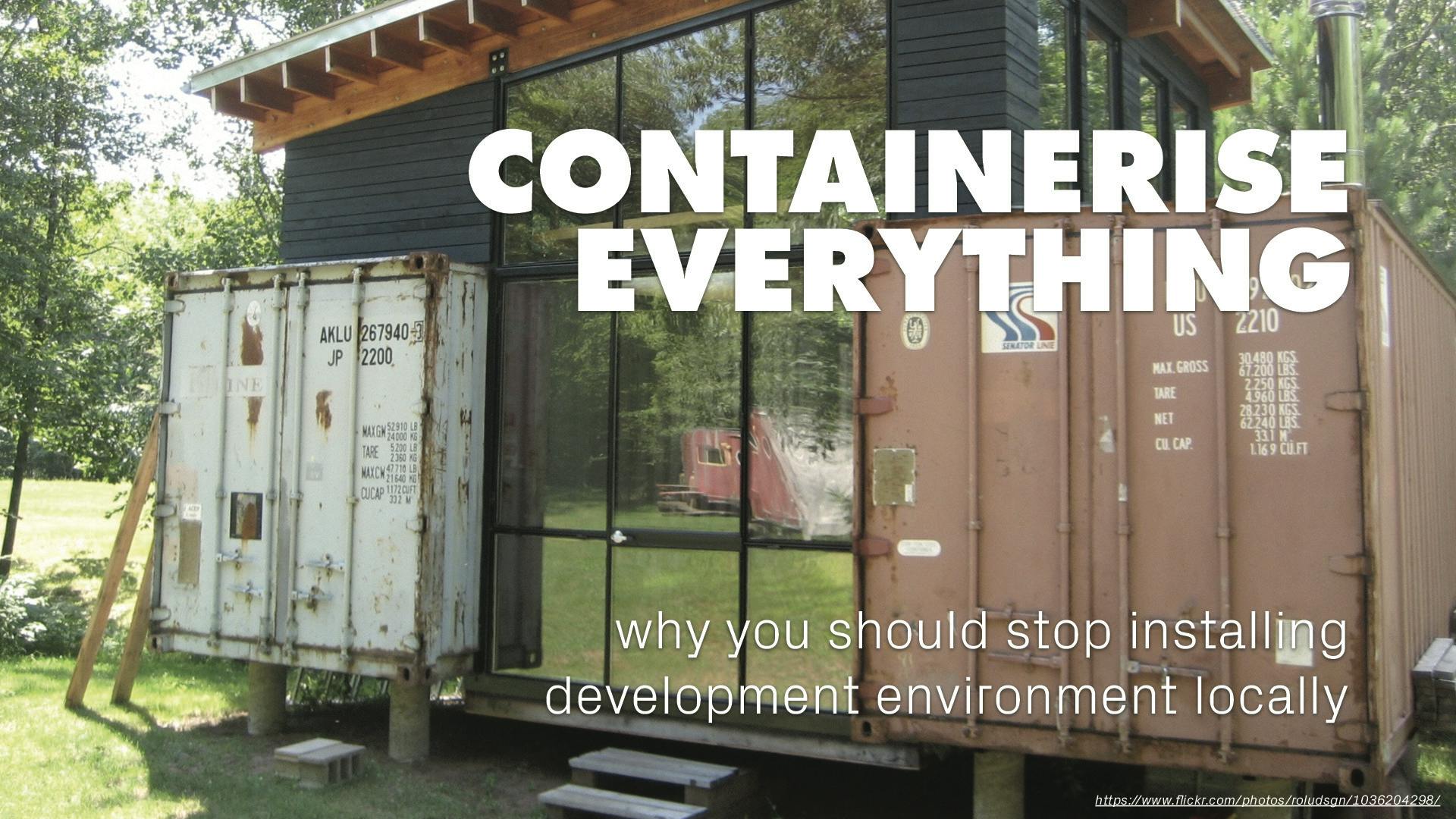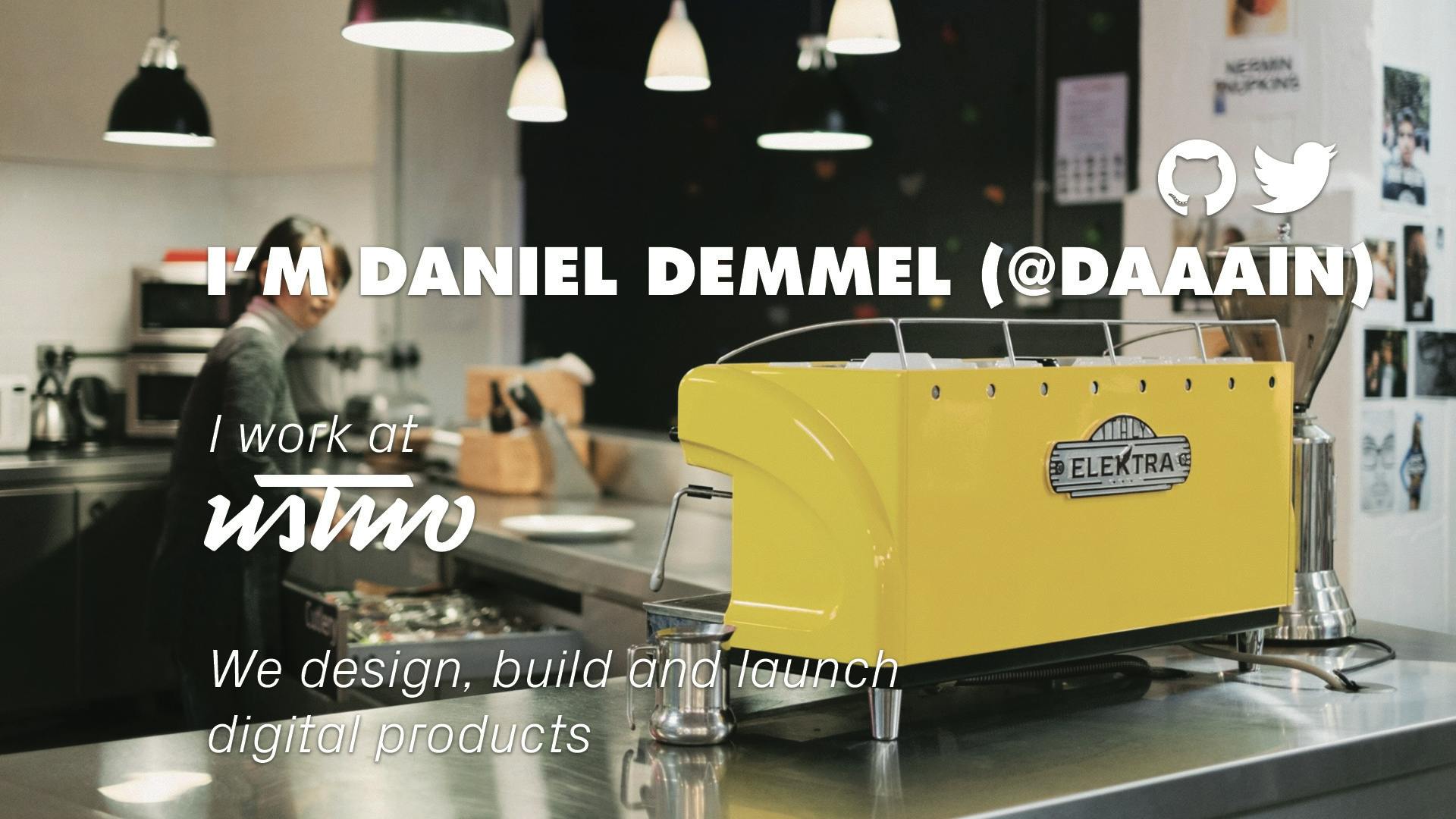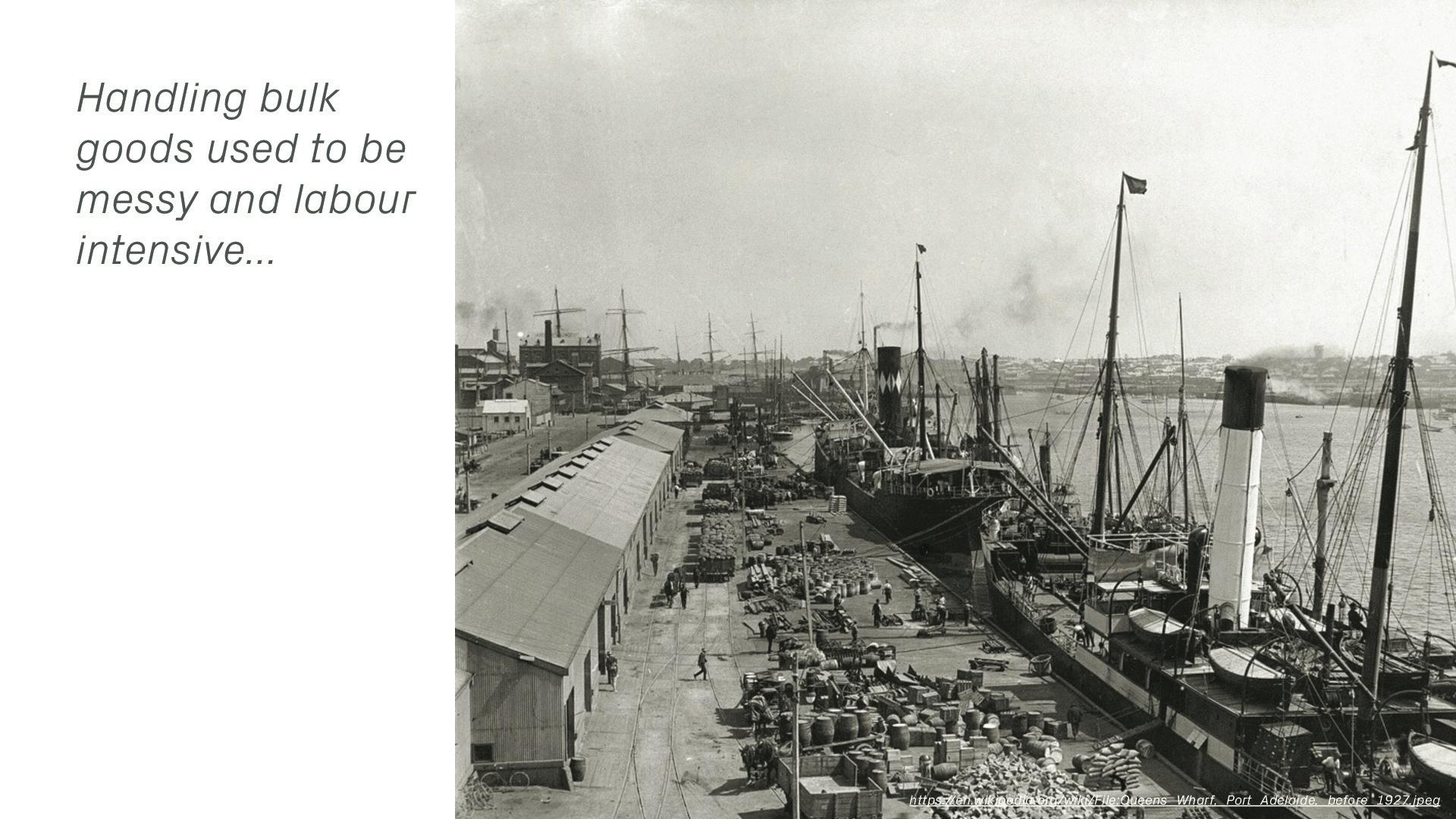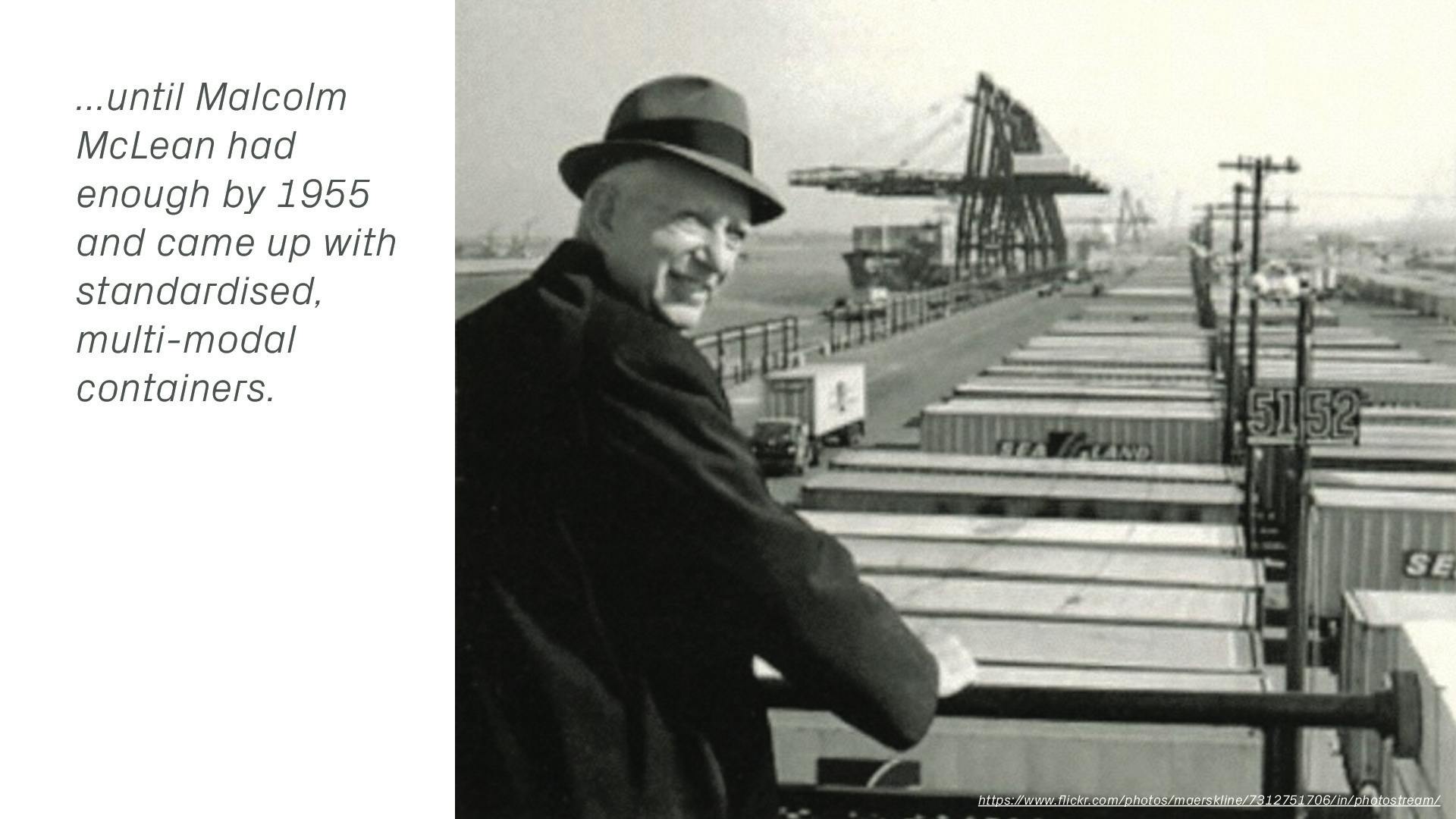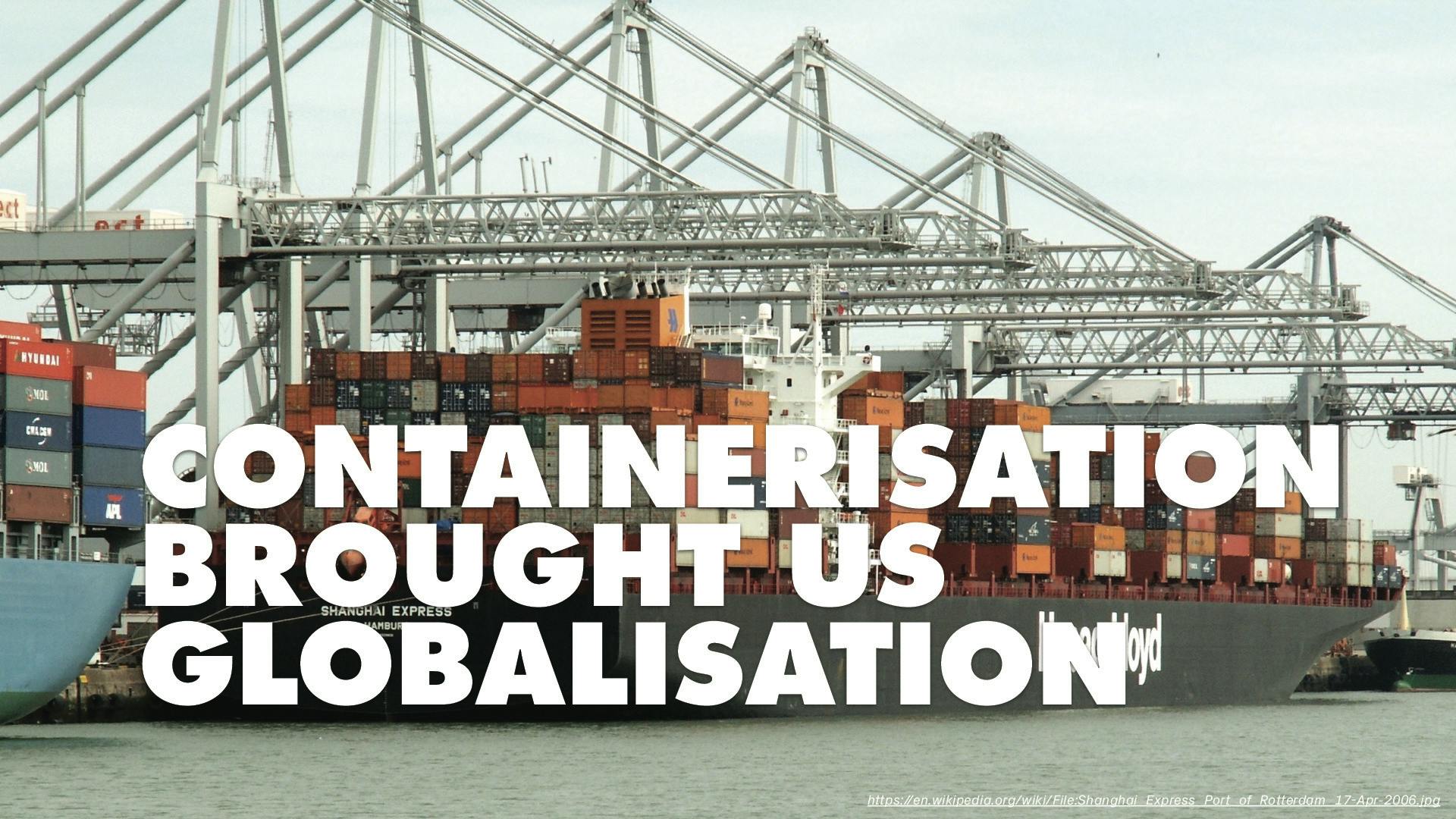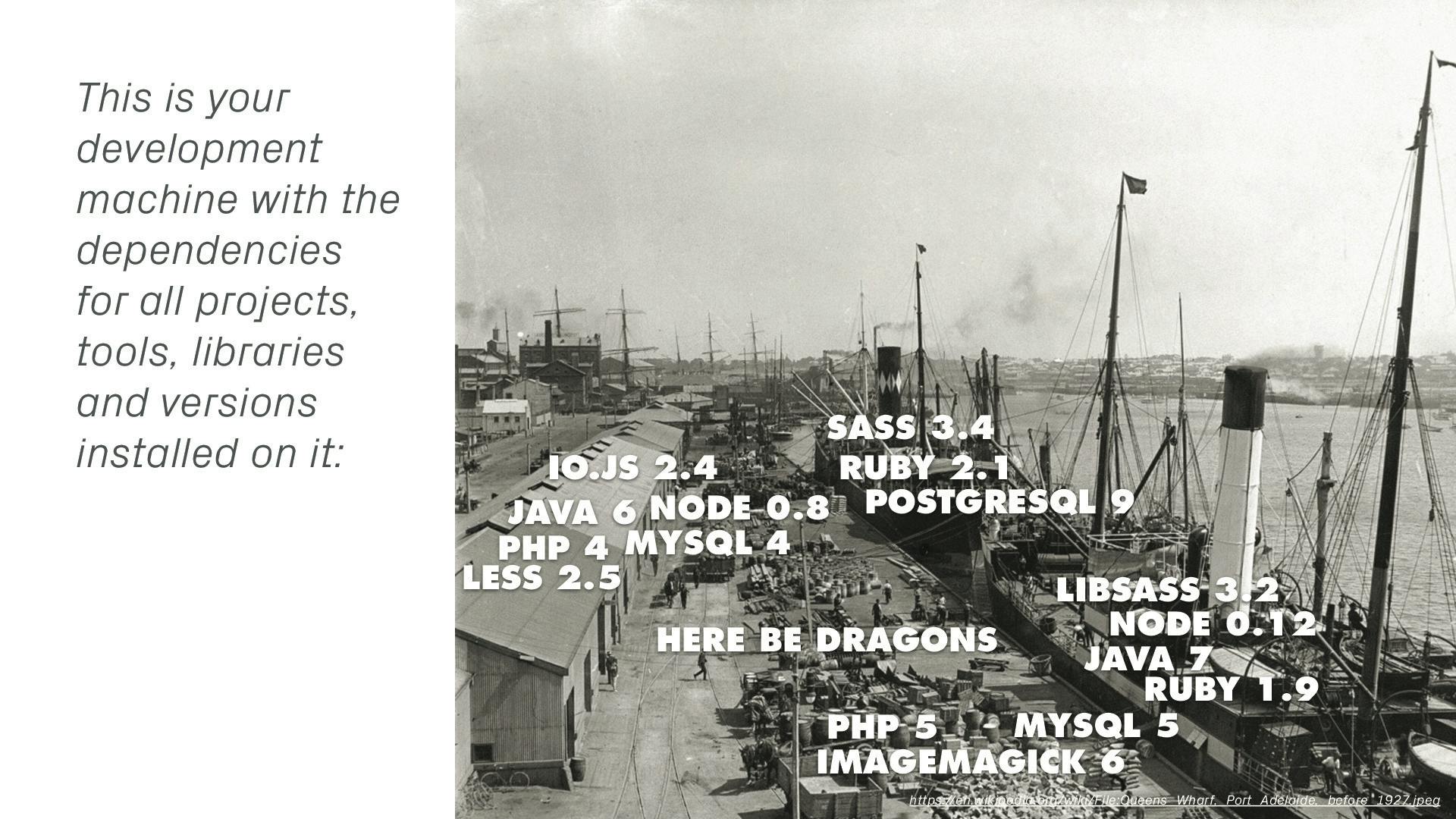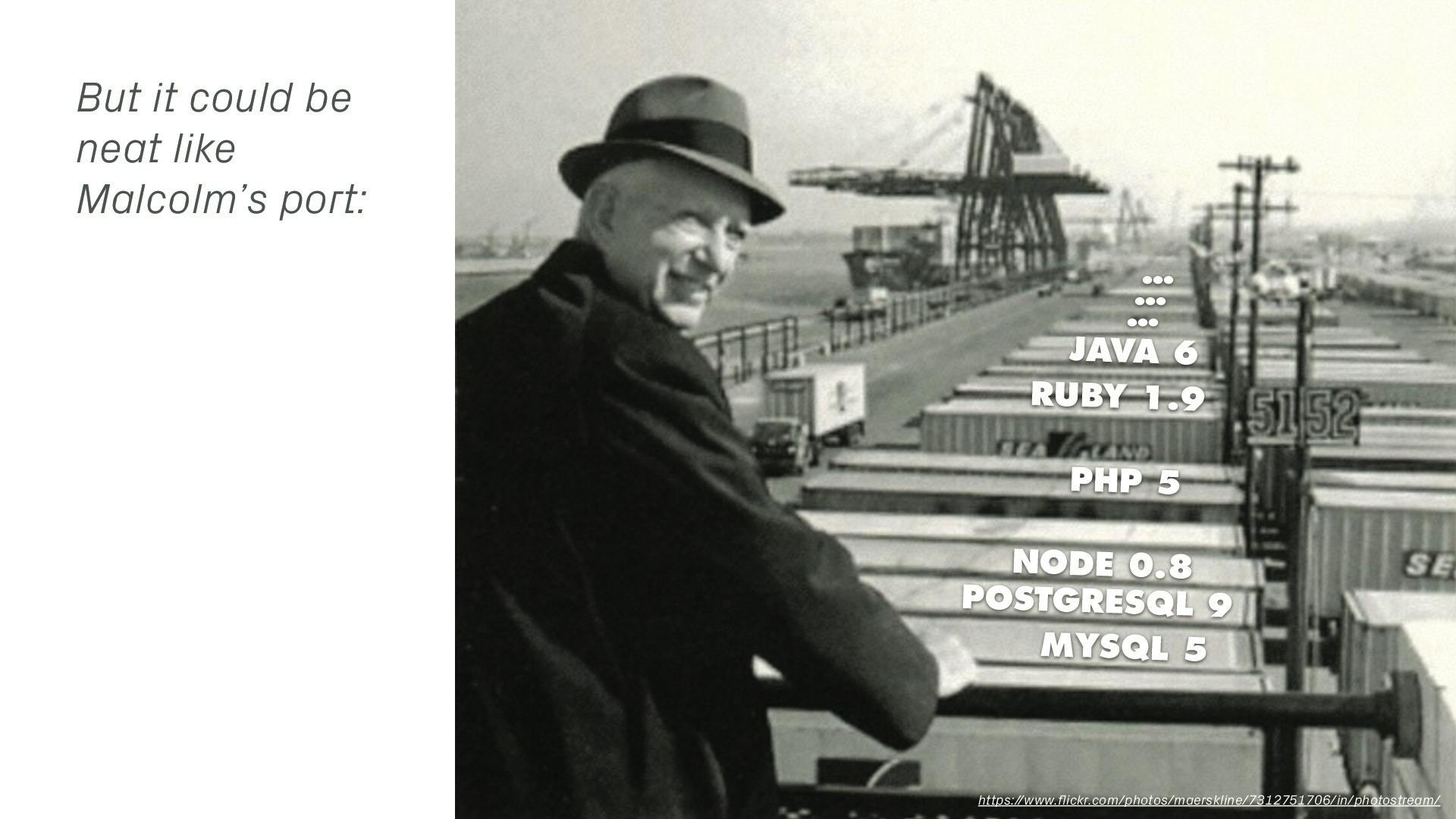- Authors
Why you should stop installing development environments locally
This is the talk I gave about containers / Docker at the re:develop conference in 2015 in Bournemouth.
In the years since, working with Docker got much simpler, if you install and download Docker for Desktop you're pretty much set without having to muck about with Docker Machine and VMs.
Video
If the embedded video above doesn't load, open it here: https://vimeo.com/782568169/4802eccb4b
Code
Make sure to also have a look at the companion repository on Github, which shows how to set up a Node based development environment with Docker. Of course it would work with anything else which runs on Linux, but this simple working example should give you a good starting point.
Transcript with individual slides
Okay. So can you hear me? Yeah. Okay. So just before we begin I will share all the slides and code examples so don't rush to take notes. It will all be available, just relax and listen.
Containers and Docker are usually discussed in more like DevOps and IT infrastructure context, but this talk is more for application developers like myself because this audience has been mostly overlooked so far, even though there are a lot of benefits of using – and abusing – this technology.
So a bit about myself, I'm a full stack developer ustwo London and we are an independent digital product studio with a nice interdisciplinary mix of designers, developers and agile coaches. And this bright yellow beauty in the foreground is our temperamental Italian coffee machine.
So, what will I talk about today? First of all, a bit of history from the shipping industry, which has some interesting parallels with software development. Then I will explain some high-level concepts around containerisation and also other approaches towards neater development environments to set some context. And finally, I will give you a tour of Docker which is the most popular containerisation technology right now.
Before we dive in, first of all just checking, can I please have a show of hands: who used some virtualisation tool like Vagrant? Okay, quite a few of you, great! And containers like Docker or LXC? Okay, so people are not completely new to the topic.
But anyway, let's start by turning our clocks back several decades to look at life on sea and in the ports. The loading and unloading of individual goods in barrels, sacks and wooden crates from land transport to ship and back again on arrival was slow and cumbersome.
Nevertheless, this process – referred to as break-bulk shipping – was the only known way to transport goods by ship up until the second half of the 20th century. Needless to say, this process was very labour intensive. A ship could easily spend more time in ports than at sea while dockworkers manhandled cargo into and out of tight spaces, below decks. There was also a high risk of accidents, loss and theft.
Fast forward to 26th of April 1956. When Malcom McLean's converted World War Two tanker – the Ideal X – made its maiden voyage from Port Newark to Houston. She had a reinforced deck carrying 58 metal container boxes as well as 15,000 tons of bulk petroleum. By the time the container ship docked at the port of Houston six days later, the company was already taking orders to ship goods back to Port Newark in containers. McLean's enterprise later became known as Sea-Land Service, a company which changed the face of shipping forever. Many famous inland ports, including London's Docklands, got completely shut down, as ever larger container ships had to use open and usually new seaside ports.
Well, this is all very nice but why should we care? In the 1950s Harvard University economist, Benjamin Chinitz, predicted that containerisation would benefit New York by allowing it to ship its industrial goods more cheaply to the southern United States than it costs from other areas like the Midwest. But what actually happened is that it became cheaper to import such goods from abroad, wiping out the state's dominant apparel industry which was meant to be its beneficiary. While I obviously can’t foresee the future, it looks like a new wave of containerisation is just about to transform software, particularly web development, with potentially some big consequences.
But let's go back to shipping for a moment. The Economist recently declared that new research suggests that the container has been more of the real driver of globalisation than all trade agreements in the past 50 years together. Well, whether you look at the dark side of globalisation like purely profit driven mega corporations or the incredible turn of history after the two world wars bringing every country working together more or less peacefully now, no one can deny that it's one of the defining trends of the late 20th century.
So let's see what are the main characteristics of shipping containers? They protect and abstract what's inside with a tough corrugated steel shell, where only the creators and the receivers need to know what's inside. They provide the standardised interface for efficient handling throughout the delivery chain. And they make it easy for everyone to scale their business quickly using this existing standard infrastructure.
But most importantly the ultimate measure of value generation both in the freight industry and in software development is how much you shipped to your end users. Getting half way on an ocean journey before losing some cargo or spending hours installing and configuring dependencies never made any customer happy.
But what is this problem after all? We all somehow managed to get set up right and deliver code, didn't we? Well, even if you only install dependencies for your projects, you have to actively work on, after a few new projects things start to become a mess. A mess that is difficult to clean up, but even harder to restore if you need to work on some old project again.
And if it's not just a few projects paying for the bills, but you also want to contribute to open source libraries, which you totally should, but that means, you need to compile them, it just gets totally out of hand...
So, what if we could have a software Malcom, locking each project's mess into digital equivalence of corrugated steel boxes? There are actually a few different solutions to restore some sanity to our development boxes.
A more light touch approach is to use package managers and runtime versions switchers in order to assemble the right combination of libraries from everything which is installed on the same computer. A more robust, sealed box approach though, is to use virtualisation and containerisation. So, let's have a quick look at these.
The simplest approach is to use package managers and install separate versions of libraries on a project by project basis rather than in the global operating system level. This actually works reasonably well as you start out, until a few years pass and you begin to have legacy projects with all the runtime versions. Or if you are working with a team where stuff randomly breaks for people on different configurations and you have to spend hours scratching your head looking at arcane error messages, I've been there.
For different runtime versions there are version switchers which alias the right binaries to execute project codebase, usually with some shell acrobatics, based on which project folder you're in or using environment variables. Things start to get a bit messy here as there can be quite a lot of plumbing to make the magic happen with more complex runtimes. And of course everyone has their favourite solution or other compromise. For example, the choice between RVM and Rbenv in the Ruby community is probably as personal as tabs versus spaces.
A completely different approach is to run an entire operating system in a virtualised environment independently of the whole system. This way, you can have an identical environment between all development computers, and even production servers. The content of these virtual boxes can be moved around either as image snapshots or rebuilt from scratch by taking existing fresh installations of different operating systems and installing dependencies with some scripted recipes.
This is a very powerful and versatile solution, but the downside is a big hit on the processor, memory, and hard disk on the host machine, having to potentially run several complete operating systems at the same time. And it takes ages to rebuild and restart as it's a full operating system with its own file system.
So taking the sealed box approach from full fat virtualisation but instead sharing the kernel and some low-level components from the host operating system, containerisation is offering the best of both worlds. Because there isn't any virtualisation happening on a container level, just drawing up and tearing down a few fences for isolation, startup is pretty much instant and the direct access to CPU and other hardware components eliminate the performance overheads. While Docker is currently the king in this space, the Open Container Initiative is taking the containerisation idea forward. It's backed by a big industry alliance including Microsoft who is promising to make it work natively on Windows. Apple though is notably absent at this point, but hope they are just taking their time.
So with these different approaches defined, we are ready to go into a bit more details about Docker, which is without doubt the go to solution right now. So Docker builds on an implementation called Linux Containers or LXC, which has been around for a while now, with quite a lot of details on how it actually works, but from user’s perspective, it's enough to know that the high level architecture is to run what's inside containers with limitation and prioritisation of resources and networking, a mounted file system and so on to create practically complete child operating systems inside the host.
Docker itself is open source and offers a large ecosystem of tools and contributions on top of the basic container technology. As our focus is application development here, I won't go into detail on the more DevOps side of things, like composition, orchestration, Swarms and so on, but let's look at the essentials which get you started.
The Docker Engine or just Docker is the core which deals with the containers themselves. It bundles together barebones Unix style utilities for handling various aspects of the containers and adds several convenience functions around them. With Docker there's a nice REST API and exposing the containers, which makes it possible both for command line tools locally and deployment scripts remotely to interact with them.
It also makes it very simple to define images with a single Dockerfile, which enables to build incremental images quickly, including downloading and compiling all the dependencies. But since Docker is Linux based, if you want to use it on Windows or Mac, it will actually need virtualisation after all, which is typically done with the open source VirtualBox and the tiny Boot2Docker image. But of course, you can have as many containers in one box as you want, inside which containers work the same way as on Linux, sharing the resources.
The Docker Hub is the place to go for community maintained images. These can be simple, base Linux distro flavours with just the bare minimum or complete application stacks from WordPress to Minecraft, ready to be started up and used.
What's an interesting Dockerfile feature is that you can build on any existing image from the Hub, so you can customise your container right from the OS or just add a few missing packages to a full-fat application. And of course, you also get webhooks, so integrating continuous integration or deployment system shouldn't be a problem.
And while I'm reasonably comfortable with the terminal shell, I’m also the first to admit that for example, understanding to do something really complex with Git, I won't bother doing it manually and will just happily do my commits, diffs and rebases in SourceTree app. So if you want to avoid the command line, that's totally fine.
Docker recently bought the similarly open source Kitematic, which is a simple but decent UI to drive Docker. What's best about Kitematic dough is that it will take care of installing all the Docker dependencies for you including VirtualBox and Boot2Docker, so you can get started without worrying about any of these. And it's even smart enough to use an existing VirtualBox installation, should you have one, which is quite refreshing compared to all the other all-in-one solutions, which just duplicate everything.
And this is the last tool for today I promise and we just mention it as a next step to look out for, once you start to get a bit more into Docker. So, once you start to have several containers between and maybe even within projects, or you want to deploy to and manage them on a cloud provider, Docker Machine will give you some simple commands to do this.
Right. So let's look at some actual code and I'll walk you through a simple Docker boilerplate repository I prepared, which is a simple, React and Sass front-end application with a bit of Express and Node service behind.
It uses a Gulp build chain and then the interesting bits which are relevant now are going to be the package.json, Dockerfile and the Makefile. And then after that, I will do a terminal browser demo, and then show how it looks in Kitematic. So, let's see.
Right. So This is the simple HTML of our app. There's a hard-coded message and then there's a bit which will get replaced by React, hopefully… And so the React app is also very simple, it just has a property with the message and then inserts it into the markup.
And there is a tiny bit of Sass or actually almost just to show the compilation as a step. And from an Express side it's also almost just a Hello World application. It's just using a bit of Handlebars to under the HTML and serves up a static server on port 8888. And also puts a message on the console, which is going to be interesting, right?
And the route couldn't be simpler, just really where there's the application. And the Gulpfile, it starts to get a bit more interesting. So, all the dependencies and then a few switches, But the first interesting bit is Sass, which is just piping through Sass and creating some source maps. And then the React bit, which is using Browserify and Babelify and Reactify to recreate things on every change and also to transpile the Babel and to separate it to vendor bundle and application bundle. And then there's the server function, which uses Nodemon and then the interesting bit here is that, since everything is going to run inside Docker and to get Browsersync working, we need to proxy it.
So depending on whether we want to use Browsersync or not, Express is going to serve up on a different port, and if we do use Browsersync, it will proxy everything through. And then that's actually what we are going to hit in development. And then, Browsersync will refresh every time it sees that the service is up and running again and then just a little bit of plumbing to get the watch going.
And I have a little bit of a tab pile up here, so I'm just going to close these…
So, the package.json: the interesting bit here is the scripts. So to make it easy and to not have to install things globally, everything is done through NPM and then this way we have a nice context to run all these different Gulp targets. And then now it's the interesting bit.
So the Dockerfile is really the recipe for Docker to get going. So, here we are just taking the official Node image and then we choose the 0.12 version and then we set the working directory inside the container. And set a few environment variables. And now, the interesting bit is that Dockers is actually quite smart about caching. So if you've worked with and Vagrant and Puppet, for example, it can, I mean, caching sometimes works, but what usually happens is that you will end up rebuilding things and that takes a lot of time, but how Docker works is that if you separate things out in a way that you copy in a file which is a dependency of the next step so in this case, the package.json in which NPM install will need but Docker will do is that it will do a checksum of the package.json and so if it sees that the file is the same, it will just skip the next step until it hits something which is different.
But then if it's different and everything after that will be invalidated. So, like one bundle here, is then installing our dependencies through NPM and the next bundle is our application code So that can be anything as a change in a Gulpfile on how we compile things or in the actual source files. And then after we copy those into the container, then we run compilation with NPM. And then we can create a volume which in this case is just exposing the logs so if you want to look at the server logs, then there's an easy interface to do that. And then on most, if not pretty much all the Docker containers, you expose a port which helps Docker to to discover and compose the different Docker containers if you have multiple of them.
And then – and I think that's mandatory actually to have – a command which is the entry point into the local container. So in this case, that would be our Node server serving up the contents, which get compiled beforehand. And then lastly, I use a Makefile (let me turn on word wrap to show how long things can get) so some of these commands with Docker can get quite long, so a bit tedious to type them in. So you can do just a shell command file, but I find Makefiles quite nice to work with. And so here you can just have nice shortcuts to all these different commands and also store some of these variables in these kinds of names and environment variables in reusable variables.
And an interesting thing to look at here is that you can define more mount points for Docker kind of runtime on the command line. So, for example, we are synchronising our source files like the package.json and the Gulpfile between the local file system where I can do my edits and the Docker instance, which will then watch those files and do things accordingly.
So I won’t go through all this comments in detail, but the most interesting bit is the Docker run, which then exposes ports on the virtual machine, which you can hit on an internal IP and then set things like the name of the container and which image should it be on the mount points and what command to run.
And so I think actually, we are ready to have a look at how it works. So, let me grab the Terminal window. So all that I've done so far here is to cd it to the right folder. Let me see. Okay, so there's this one development virtual machine running, but it's not the active one. So I think I will have to select it.
Right. So basically, what's happening here is that Docker Machine can handle images on cloud providers as well. So say for example if you are working with Amazon, you can go directly from your command line and do different kind of container management that's over there. So you need to tell it in which context should it work, because the Docker command what will work on a certain environment or virtual machine at the time. So here and there are two approaches, first is to put all these exports into your share profile. But then, what's more flexible is to just for each terminal session set this context here.
So now this will enable our Docker to look at what's running right now. It's nothing. But these Docker knows now which virtual box to work with. So we should be ready to fire up our container. So this is the long Docker run command and it got back to us with a big hash which should be the hash of this container.
So, let's peek inside. This is what you would normally see on your local machine if you just run Gulp. So it's just doing all this compilation and starting the server and you could see that by the time I managed to log in, it's already done with all these and then the server’s up and running.
So the containers are really kind of throw-away things. You can just really quickly start them off and throw them away. So, let's actually exit from here and see what is our IP address? So Docker Machine gave us this one and then I will plug this in the browser. And let's see what's inside.
All right, great, so it worked!
Let me try to see if I change something, what will happen. Let’s save this and go back. Yeah, so this managed to refresh the browser from inside the Docker container. So it means that Docker picked up the change through this volume which is inserted, run the compilation again and push the update through to the browser.
So if we peek again then we will see that at the end. Yeah, so there was a Reactify which recompiled everything and then Browsersync reloaded the browsers.
And then, the last bit I wanted to show is Kitematic. So, this is actually the currently running container and it shows what's going on inside. And also would give other handy information like what ports are exposed, what volumes there are. And I think some of it is cut off because the resolution is too small, but it shows things like environment variables.
So it's a really kind of nice way to be able to have a look, what's running. Because you can have tons of containers. And also, yeah, you can kill it from here and even completely remove it.
And this click target is... All right, okay, there's a dialogue on the other screen. And so here you can actually search for images and it's an interesting mix. So some of them are just going to be some simple Linuxy bits. But yeah, you can get full things like Jenkins or Ghost blogging platform or Minecraft and everything.
So it actually has an interesting place outside development as well. If you just quickly want to grab something and run it and not worry about “Oh my god. What do I need to have? What language is it even written in?” You just don’t really need to care and just set it up and it’s quite cheap and easy.
Okay, so coming back to my presentation – and I promise I didn't talk to Mike before putting the presentation together, but actually – I mentioned having multiple containers earlier when talking about Docker Machine, but you might have been wondering, why would you do that? So I think – and a lot of people will say that it's not true – but I think it's a perfectly valid way to use a container as an all-in-one system to just have a simple and quick development environment setup. But then it's worth mentioning that actually the way Docker is designed is to split your application up to smaller easily interchangeable pieces, with only one process per container. And also data should be kept in a separate data volume, which won't do anything other than persisting data be it files or databases.
So just as a simple example, I drew up a WordPress website. If you had a website with heavy traffic, then you can just have an architecture where you start breaking these things up. So you could have like this, Apache webserver and then the PHP of WordPress and then MySQL database engine and then the actual database itself and then all the uploaded images and then media.
And so, and it might sound like a lot of work, but since each of these containers feel essentially be a microservice or part of a pipeline, you can very easily test, scale and update the live environment. So for example if you need to add the database mirror because that ends up being the bottleneck, then you can do it without having to redo everything because it's not just contained by one, monolithic server instance. And of course, the connections themselves become much more apparent. So it will make you think of interfaces and how you define them. So I think this is a really good way to start thinking of development. So it's not only Docker will make it easy to get started with the clean and isolated environment, it will also guide you to think in a way how you actually want to compose your service once it's out there in production.
And so, you can quote me on this because I'm fairly confident that we see more and more open source projects, especially complex ones embrace containerisation for dependency management. Because all it takes after all, is someone adding a single Dockerfile and in most cases, people can still choose not to use it and just go with the existing local setup.
So actually started to do that with some old projects and it worked really well because some people already had it working and they just kept on doing their thing, but then I didn't need to worry about all of the dependencies. And for example I don't usually work with PHP much and then I was looking at the README and 70% of it was like if this goes wrong then you need to do that and it was all in this setup things and of course, it was written for Mac, which is not the production environment. So, then I did need to spend a couple of hours to set the Dockerfile up, but that should make it much easier for everyone coming after me to do this.
But then going back to the open source projects, I think using containers specifically for development environments, we will create a dramatically lower barrier of entry for newcomers to a project. And this can enable potentially an order of magnitude more people to get involved, just like Git and GitHub did.
So, it doesn't really matter if you want to use a simple library and actually the nicest one is a language which you don't often use but and and you find a small tweak there, but then the only way the project maintainers will accept a pull request is if you write a test and if you compile that and then the minified or however compiled version is updated, then it can take actually a lot of work to set it up and so we might end up just not bothering with it or just putting in an issue and not really setting it up.
But if it's so easy that you just bring the container down and then you just do a change in the text editor, not even really caring about the language itself or learning the intricacies of it and understanding what package manager it even uses then I think it is going to have huge impact and it will make it so much easier for people to also get themselves familiar with programming languages which they just didn't want to get around to try because it might be in just kind of a low long and honours task to set up.
So, yeah, that was most of what I wanted to say. And I left a little bit of time at the end. So yeah, if you have any questions, then please fire away and they're all the links here. So I haven't quite put up the slides yet, but they are going to go on my blog on this URL.
